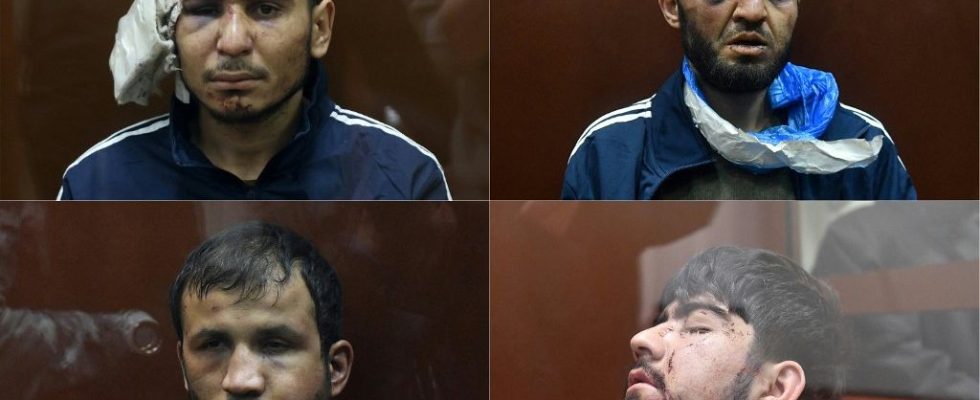Arrested a few hours after the Moscow attack which left at least 137 dead, four suspects, some from Tajikistan, were taken before a Moscow court. On Sunday, two of them pleaded guilty. All were charged with terrorism and placed in pre-trial detention. But images of their interrogation or videos posted on social networks gave rise to allegations of torture. Update on this matter.
What do the images and videos shown show?
The faces of the suspects, photographed in a Moscow court, quickly went around the web. One of them arrived in a wheelchair, his eyes closed, his chest partially exposed and his face covered in dried blood. Another showed up with a huge bandage around his right ear, while a third, his face distorted by numerous bruises, was wearing a white and blue plastic bag around his neck.
The Russian site in exile Meduza claimed that the alleged attackers were “tortured during interrogation”. Polish media Visegrad 24 relayed a photo on Sunday showing a man on the ground with an electric generator connected to his genitals. For its part, AFP mentioned a video broadcast on social networks on Saturday, in which an individual pinned to the ground has his ear cut off, before being forced to eat it. However, the authenticity of this document has not been proven, which does not make it possible to formally establish a link with the man with the bandage.
France 24 a also broadcast video extracts able to attest to the use of torture against suspects. Filmed on camera, they confess to having been paid half a million rubles (around 5,000 euros). They also reveal that they were contacted via Telegram by someone they did not know.
Asked by journalists about these allegations of torture, Dmitri Peskov, Vladimir Putin’s spokesperson, made no comment. “I will leave this question unanswered,” he simply declared.
What do the experts think?
“There is little room for doubt,” replies Marie Struthers, regional director for Eastern Europe and Central Asia at Amnesty International. It is difficult to believe that this is not true, given what we know about the history of repression and the use of torture or ill-treatment within the Russian justice system. »
“This is very concerning. People suspected of terrorist attacks are not the only ones to be tortured. Since the invasion of Ukraine, we have seen what is happening in detention centers, we have seen the mistreatment of ordinary citizens. Everything has accelerated, observes Marie Struthers. Those who dare to peacefully express an opinion contrary to the war in Ukraine are mistreated or tortured. » And added: “We only have to look at very recent examples such as the cases of Alexeï Navalny or Alexeï Gorinov”.
“The fact that these four suspects were tortured is not surprising,” says Anna Colin Lebedev, political science researcher and specialist in post-Soviet societies, for whom there “is no doubt,” either. “Torture by police and prison institutions has been documented in Russia for many years thanks to NGOs and the media,” she says.
What is the impact of these images?
“Video recording of these torture sessions, particularly for reporting purposes, is a practice that we have seen spread in recent years. This allows us to have a trace to show to superiors,” says Anna Colin Lebedev, emphasizing that in the Russian judicial system, “evidence obtained under torture is admissible.” The “new thing”, on the other hand, is the distribution of these videos “in the general public space”, and no longer internally.
“These images were broadcast by Telegram channels whose links with the police are known. It is possible that there is some sort of approval from the authorities, even if it is not official,” analyzes the researcher who sees in this process a “desire to demonstrate and intimidate.”
“As the police did not succeed in foiling the attack or quickly intervening on the scene, the broadcast of these videos makes it possible to promote the success of the arrest of the suspects to show that the State does not remain not with your arms dangling. And that the suspects are treated unceremoniously, she argues. What matters is not the judgment in a court of law but the demonstration of force. »
What does Russia risk?
“Torture is totally and completely prohibited, according to international law,” recalls Marie Struthers. Russia, like 157 other states, ratified the convention against torture in 1987.
“If there is evidence of torture, it is a crime. Those responsible must be brought to justice,” she continues. Just like the attackers. “Torture only leads to fear and suppression of the truth. It does not in any way provide justice to the victims or their loved ones. Nor to demonstrate transparency,” concludes Marie Struthers.

